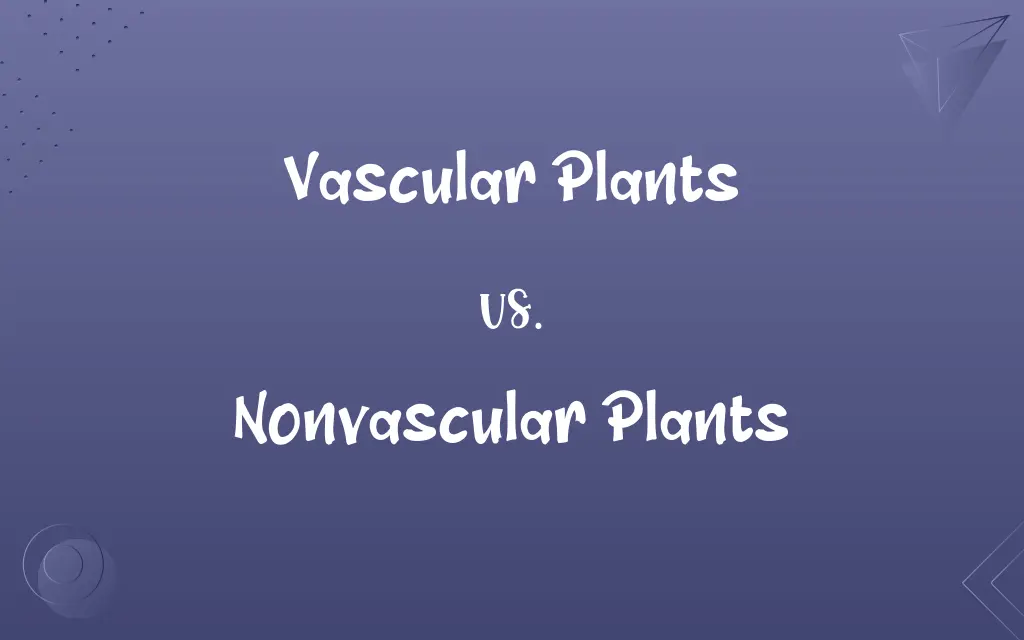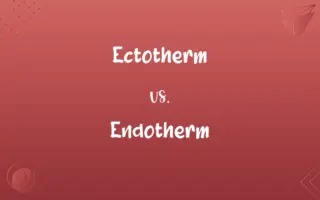Vascular Plants vs. Nonvascular Plants: Know the Difference

By Shumaila Saeed || Updated on December 25, 2023
Vascular Plants have specialized structures like xylem and phloem for nutrient transport, while Nonvascular Plants lack these and rely on direct water absorption.

Key Differences
Vascular Plants possess specialized transport systems, xylem and phloem, for water and nutrient movement, unlike Nonvascular Plants, which lack such systems and absorb water and nutrients directly from their environment.
Shumaila Saeed
Dec 15, 2023
In Vascular Plants, the presence of roots, stems, and leaves facilitates efficient nutrient and water distribution, features that are absent or rudimentary in Nonvascular Plants.
Shumaila Saeed
Dec 15, 2023
Vascular Plants typically achieve greater height and structural complexity due to their vascular systems, whereas Nonvascular Plants are generally smaller and grow close to the ground.
Shumaila Saeed
Dec 15, 2023
Reproduction in Vascular Plants often involves seeds or spores, and they have complex life cycles, contrasting with Nonvascular Plants, which primarily reproduce through spores and have simpler life cycles.
Shumaila Saeed
Dec 15, 2023
The habitat range of Vascular Plants is extensive due to their efficient water transport, in contrast to Nonvascular Plants, which are often found in moist environments due to their reliance on direct water absorption.
Shumaila Saeed
Dec 15, 2023
ADVERTISEMENT
Comparison Chart
Structural Features
Roots, stems, and leaves present
Lack or have rudimentary roots and leaves
Shumaila Saeed
Dec 15, 2023
Size and Complexity
Larger, more structurally complex
Smaller, simpler in structure
Shumaila Saeed
Dec 15, 2023
Reproduction
Seed or spore-based, complex life cycles
Mainly spore-based, simpler life cycles
Shumaila Saeed
Dec 15, 2023
Preferred Habitat
Wide range, not limited to moist areas
Typically found in moist environments
Shumaila Saeed
Dec 15, 2023
ADVERTISEMENT
Vascular Plants and Nonvascular Plants Definitions
Vascular Plants
Typically have roots, stems, and leaves.
Vascular Plants like ferns have well-defined leaves.
Shumaila Saeed
Dec 03, 2023
Nonvascular Plants
Absorb water and nutrients directly from surroundings.
Nonvascular Plants like liverworts rely on surface moisture.
Shumaila Saeed
Dec 03, 2023
Vascular Plants
Can grow larger and taller due to their vascular system.
Vascular Plants such as redwoods reach great heights.
Shumaila Saeed
Dec 03, 2023
Nonvascular Plants
Have simpler structures without true roots or leaves.
In Nonvascular Plants, structures analogous to leaves are simple.
Shumaila Saeed
Dec 03, 2023
Vascular Plants
Plants with a complex system for water and nutrient transport.
Oak trees are Vascular Plants with extensive root systems.
Shumaila Saeed
Dec 03, 2023
ADVERTISEMENT
Nonvascular Plants
Plants that lack specialized transport systems.
Mosses are Nonvascular Plants growing in damp areas.
Shumaila Saeed
Dec 03, 2023
Vascular Plants
Have more complex life cycles involving seeds or spores.
Flowering Vascular Plants reproduce via seeds.
Shumaila Saeed
Dec 03, 2023
Nonvascular Plants
Reproduce primarily through spores.
Spore dispersal is a key reproduction method in Nonvascular Plants.
Shumaila Saeed
Dec 03, 2023
Vascular Plants
Characterized by the presence of xylem and phloem.
In Vascular Plants, xylem and phloem are essential for growth.
Shumaila Saeed
Dec 03, 2023
Nonvascular Plants
Generally small and grow close to the ground.
Nonvascular Plants often form dense, low mats on rocks.
Shumaila Saeed
Dec 03, 2023
Repeatedly Asked Queries
What are Vascular Plants?
Plants with specialized structures for nutrient transport.
Shumaila Saeed
Dec 15, 2023
Are Nonvascular Plants typically tall?
No, they are usually small and ground-hugging.
Shumaila Saeed
Dec 15, 2023
What is the reproduction method of Vascular Plants?
Through seeds or spores.
Shumaila Saeed
Dec 15, 2023
What are the three main groups of nonvascular plants?
The three main groups of nonvascular plants are mosses, liverworts, and hornworts.
Shumaila Saeed
Dec 15, 2023
Where are nonvascular plants commonly found?
Nonvascular plants thrive in moist environments, such as damp forests, wetlands, and rocky surfaces.
Shumaila Saeed
Dec 15, 2023
Do nonvascular plants photosynthesize?
Yes, nonvascular plants can photosynthesize, as they have chloroplasts in their cells.
Shumaila Saeed
Dec 15, 2023
What is the life cycle of nonvascular plants like?
The life cycle typically involves alternation of generations, with haploid (gametophyte) and diploid (sporophyte) stages.
Shumaila Saeed
Dec 15, 2023
Are there any economically significant nonvascular plants?
Sphagnum moss, a type of nonvascular plant, is used in horticulture and as a soil conditioner.
Shumaila Saeed
Dec 15, 2023
What challenges do nonvascular plants face due to their lack of vascular tissue?
Nonvascular plants face limitations in size, as they cannot efficiently transport water and nutrients over long distances.
Shumaila Saeed
Dec 15, 2023
Share this page
Link for your blog / website
HTML
Link to share via messenger
About Author
Written by
Shumaila SaeedShumaila Saeed, an expert content creator with 6 years of experience, specializes in distilling complex topics into easily digestible comparisons, shining a light on the nuances that both inform and educate readers with clarity and accuracy.







































































